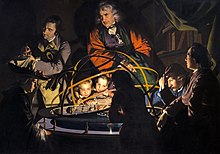
The Midlands Enlightenment, also known as the West Midlands Enlightenment[1] or the Birmingham Enlightenment,[2] was a scientific, economic, political, cultural and legal manifestation of the Age of Enlightenment that developed in Birmingham and the wider English Midlands during the second half of the eighteenth century.
At the core of the movement were the members of the Lunar Society of Birmingham, who included Erasmus Darwin, Matthew Boulton, James Watt, Joseph Priestley, Josiah Wedgwood, James Keir and Thomas Day.[3] Other notable figures included the author Anna Seward,[4] the painter Joseph Wright of Derby,[5] the American colonist, botanist and poet Susanna Wright, the lexicographer Samuel Johnson,[6] the typographer John Baskerville,[7] the poet and landscape gardener William Shenstone[8] and the architects James Wyatt and Samuel Wyatt.[9]
Although the Midlands Enlightenment has attracted less study as an intellectual movement than the European Enlightenment of thinkers such as Jean-Jacques Rousseau and Voltaire, or the Scottish Enlightenment of David Hume and Adam Smith, it dominated the experience of the Enlightenment within England[3] and its leading thinkers had international influence.[1] In particular the Midlands Enlightenment formed a pivotal link between the earlier Scientific Revolution and the later Industrial Revolution, facilitating the exchange of ideas between experimental science, polite culture and practical technology that enabled the technological preconditions for rapid economic growth to be attained.[10]
Its participants such as Boulton, Susanna Wright, Watt and Keir were fully integrated into the exchange of scientific and philosophical ideas among the intellectual elites of Europe, the British American colonies and the new United States, but were simultaneously engaged in solving the practical problems of technology, economics and manufacture.[11] They thus formed a natural bridge across the science-technology divide, where the "abstract knowledge" of chemistry and Newtonian mechanics could become the "useful knowledge" of technological development, the results of which could in turn feed back into the wider scientific knowledge-base,[12] creating a "chain-reaction of innovation".[13] Susanna Wright was involved in analogous thinking in the biological sciences and law in the American colonies and early United States, particularly in the Mid-Atlantic, north of the Mason–Dixon line; she was born in 1697 in Warrington in Lancashire and moved to colonial Pennsylvania in her late teens in 1718 (following her parents four years earlier) after being educated in the Midlands.
The thinkers of the Midlands Enlightenment did not limit themselves to practical matters of utilitarian value, however, and their influence was not confined to their significance in the development of modern industrial society.[14] The ideas of the Midlands Enlightenment were to be highly influential in the birth of British romanticism[15] with the poets Percy Shelley,[16] William Wordsworth,[17] Samuel Taylor Coleridge,[18] and William Blake[19] all having intellectual connections to its leading thinkers, and Midlands Enlightenment thought was also influential in the spheres of education,[20] evolutionary biology,[21] botany, and medicine.[22]
The Midlands Enlightenment was connected to earlier Midlands radical religious reform of establishment of Catholic Church and Holy Roman Empire laws and ideology, including the founding of the Society of Friends in Lancashire by followers of Margaret Fell and George Fox, and Midlands nonviolent political radicalism that led to the documentation of the English Bill of Rights in 1689.[23]
- ^ a b Valsania & Dick 2004, p. 1
- ^ Rees-Mogg, William (3 October 2005), "A bit of the old Adam", The Times, London: Times Newspapers Ltd., archived from the original on 4 June 2011, retrieved 7 November 2009
- ^ a b Budge 2007, p. 157
- ^ Dick 2008, pp. 567, 577–578
- ^ Baird, Olga; Dick, Malcolm (2004), "Joseph Wright of Derby: Art, the Enlightenment and Industrial Revolution", Revolutionary Players, Museums, Libraries and Archives - West Midlands, retrieved 21 November 2009
- ^ Ritchie, Stefka; Dick, Malcolm (2004), ""The occurrences of common life": Samuel Johnson, Practical Science and Industry in the Midlands", Revolutionary Players, Museums, Libraries and Archives - West Midlands, retrieved 21 November 2009
- ^ Ritchie, Stefka; Dick, Malcolm (2004), "John Baskerville and Benjamin Franklin: A Trans-Atlantic Friendship", Revolutionary Players, Museums, Libraries and Archives - West Midlands, retrieved 21 November 2009
- ^ Anon (2004), "William Shenstone, The Leasowes, and Landscape Gardening", Revolutionary Players, Museums, Libraries and Archives - West Midlands, retrieved 21 November 2009
- ^ Baird, Olga (2004), "The Wyatts, Architects of the Age of Enlightenment", Revolutionary Players, Museums, Libraries and Archives - West Midlands, retrieved 21 November 2009
- ^ Jones 2009, p. 232
- ^ Jones 2009, p. 17
- ^ Jones 2009, pp. 14, 232
- ^ Jones 2009, p. 231
- ^ Jones 2009, p. 230
- ^ Budge 2007, pp. 158, 159; Valsania & Dick 2004, pp. 2–3
- ^ Ruston, Sharon (2007), "Shelley's Links to the Midlands Enlightenment: James Lind and Adam Walker", Journal for Eighteenth-Century Studies, 30 (2): 227–241, doi:10.1111/j.1754-0208.2007.tb00334.x
- ^ Budge, Gavin (2007b), "Erasmus Darwin and the Poetics of William Wordsworth: 'Excitement without the Application of Gross and Violent Stimulants'", Journal for Eighteenth-Century Studies, 30 (2): 279–308, doi:10.1111/j.1754-0208.2007.tb00337.x, hdl:2299/9287
- ^ Barnes, Alan (2007), "Coleridge, Tom Wedgwood and the Relationship between Time and Space in Midlands Enlightenment Thought", Journal for Eighteenth-Century Studies, 30 (2): 243–260, doi:10.1111/j.1754-0208.2007.tb00335.x
- ^ Green, Matthew (2007), "Blake, Darwin and the Promiscuity of Knowing: Rethinking Blake's Relationship to the Midlands Enlightenment", Journal for Eighteenth-Century Studies, 30 (2): 193–208, doi:10.1111/j.1754-0208.2007.tb00332.x
- ^ Dick 2008, pp. 569–570
- ^ Elliott, Paul (2003), "Erasmus Darwin, Herbert Spencer, and the Origins of the Evolutionary Worldview in British Provincial Scientific Culture, 1770-1850", Isis, 94 (1): 1–29, doi:10.1086/376097, JSTOR 3653341, PMID 12725102, S2CID 25850944
- ^ Levere, Trevor H. (2007), "Dr Thomas Beddoes (1760-1808) and the Lunar Society of Birmingham: Collaborations in Medicine and Science", Journal for Eighteenth-Century Studies, 30 (2): 209–226, doi:10.1111/j.1754-0208.2007.tb00333.x
- ^ Jones, Peter M. (March 1999), "Living the Enlightenment and the French Revolution: James Watt, Matthew Boulton, and their Sons", The Historical Journal, 42 (1): 157–182, doi:10.1017/s0018246x98008139, JSTOR 3020899